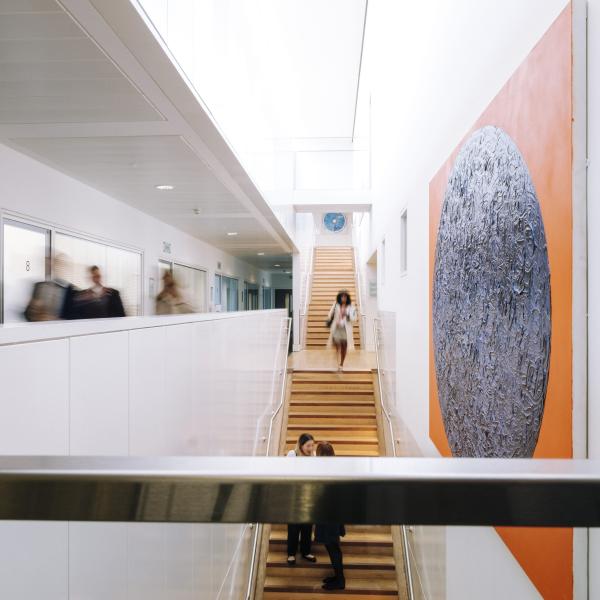Artist Julie Brook spoke about her work as part of the Art at Oxford Saïd series.
Brook described a sculptural journey across continents from the Hebrides to Japan. The interconnectedness of life and work, the influence of landscape, especially over time, and the importance of ‘making’ were some of the major themes that ran through her talk.
Some of the most arresting pieces in the exhibition at the School date from the three and a half years she spent living and working on Jura, off the west coast of Scotland. As she revealed in a short piece of film, she chose to make her home in a natural arch of rock – very dramatic and beautiful but clearly very cold. She built a wind baffle out of driftwood to give herself more shelter, and later a small house at the back of the arch. This physical work had an important influence on her artistic work. ‘I was taking big canvasses out … and I was observing the landscape and trying to really understand the physical mass in a sense of this raw response and structure to the landscape’, she said. But when she started on the functional building, she felt that she wanted to ‘find an expression of the work that was much more directly expressive of that connection I felt with the landscape I was seeing every day.’
The extraordinary ‘Fire stacks’ in the sea were a way of bringing all the elements together, said Brook, and she described working with the tide. ‘I thought it would be very exciting working with something that I was both creating that would inherently be destroyed as well … It gave me the beginning of that sensation of really bodily knowledge when you learn something from physically experiencing it.’
Another photograph also illustrated the quality that came from experiencing the work as she was making it. ‘Stone Bowl’ on Mingulay was started to ‘reflect this lovely bowl like form of the east coast that was in so much contrast with the harsh verticalities of the west coast. … I was primarily concerned with this shallow, bowl-like form, but the deeper part of the bowl is quite hard against the rock bed and when it started raining after I had just made it, it just filled naturally with water and I realised it was all about the water and therefore the light.’ She said that, ‘often what I make is not actually the work. It’s the means to find the essence of the work.’
Speaking particularly to the young people in the audience, she said that work can also require a certain playfulness. ‘You need to be quite light on your feet and be prepared to try things out.’
After about 20 years of living and working in Scotland, Brook was given an opportunity to work in the desert of Libya. During her talk she interspersed pictures of the landscape and the works she created by ‘very simple realignment and materials … just shifting the orientation’ with ‘behind the scenes’ stories of travelling with her guides. She learned how to make desert bread, for example, and kept her (bottled) water cool with a hessian bag that the guide kept wet.
‘I mention these things because I think the way we live really does inform how we make work in different ways and in ways that you don’t necessarily formulate or articulate,’ she said.
Other works in the exhibition reflect the black, volcanic desert she travelled through in Libya (‘it felt like I was experiencing what the earth might have looked like at the beginning of time’) and the animals she encountered in Namibia: ‘it’s that feeling of when you’re really experiencing something directly, not through books or through pictures, but you’re seeing them and living with them. I was so inspired by their natural calligraphic markings and how they contribute to their camouflage to hide from predators and it made me really alert to how absent the light and shadow is there.’
A striking feature of the works that she showed from around this time was the rich red earth – thrown in the air by her guide, colouring the rocks and reflecting the light, and featuring in a series of drawings. This earth was used by the nomadic Himra people in Namibia to put on their skin. Mixed with animal fat it is both protective and aesthetic. Brook explained how she managed to tag along with three young girls who were going to collect the pigment by lending them her pickaxe. ‘It was like going down a throat-like cave into pure red pigment,’ she said. ‘It’s very, very hard so really we were giving it all our strength to pick out tiny tips of it.’
Years later, having met the 15th-generation Raku tea-bowl maker Raku Kichizaemon in Japan, Brook asked him, ‘Would you like some of this Namibian pigment?’ And he said he would. ‘So I sent him some pigment and it eventually arrived in Japan and he said, “Isn’t it marvellous? You collected it in Namibia. It’s gone all the way to Scotland and then it’s come all the way over to me in Japan.”
Around that time, an old temple was demolished in in Kyoto, near where Raku lives, revealing some thousand-year-old clay which was offered to the artist. He combined this clay with the Namibian pigment, and Brook announced that the new bowls he made are about to be exhibited in Tokyo. ‘When you think of the journey in time and in all sorts of ways with these bowls, I think there’s something really amazing about them,’ she said.

